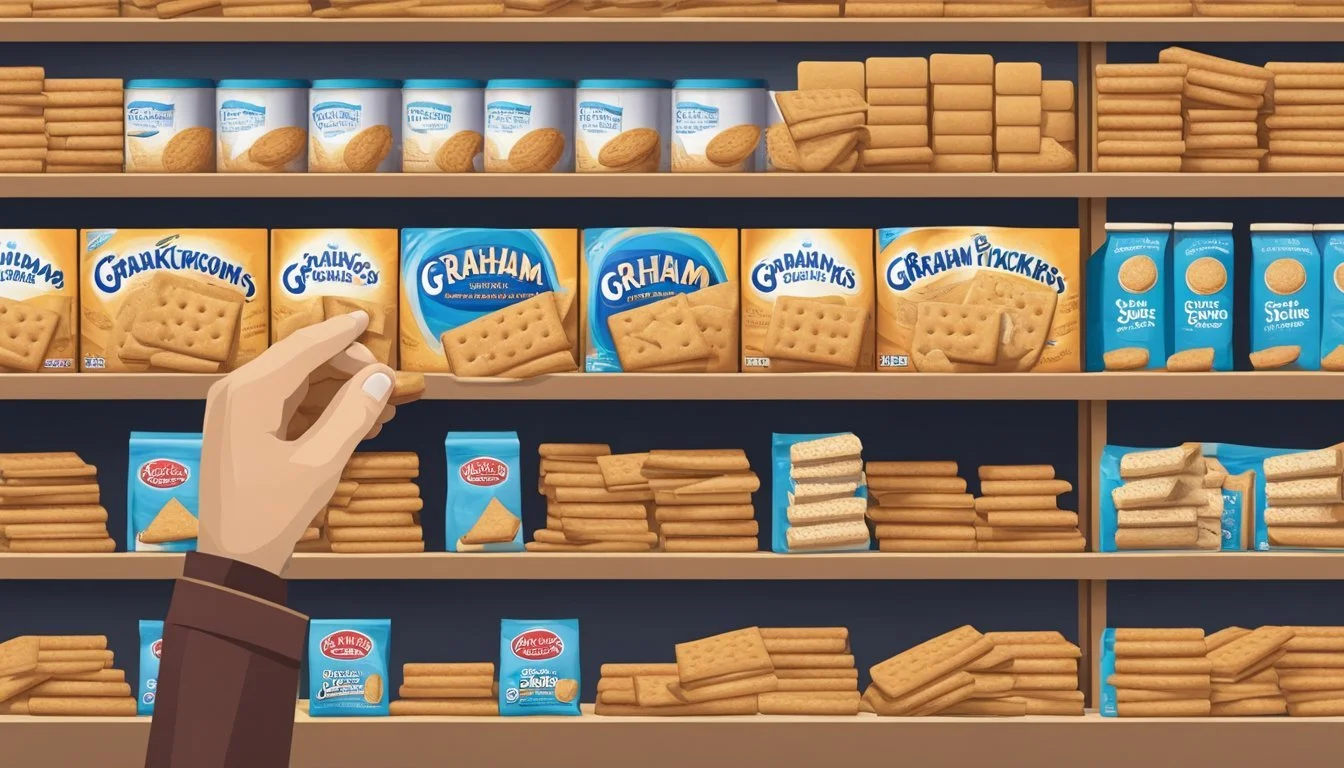Do Graham Crackers Go Bad?
Shelf Life and Storage Tips
Graham crackers are a staple in many households, often used for everything from after-school snacks to pie crusts. But like any other pantry item, they come with a question regarding their longevity. Yes, graham crackers can go bad, and their shelf life depends on several factors including how they're stored and whether the package has been opened.
Unopened packages of graham crackers typically last between 6 to 9 months if stored in a cool, dry place. Once opened, the shelf life decreases significantly, and they should be consumed within 4 to 6 weeks for optimal taste and texture. Proper storage in an airtight container can help extend their freshness.
One key sign that graham crackers have gone bad is mold growth. Mold can produce harmful toxins and pose a health risk, making it crucial to check for any visible spoilage. If the crackers are just a bit stale but mold-free, they are usually still safe to eat, though they may not be as enjoyable.
Understanding Graham Crackers
Graham crackers have a rich history and come in various forms, each with unique ingredients and purposes. Their composition often includes whole wheat flour, sugar, and honey, among other elements.
History and Purpose
Graham crackers originated in the early 19th century, created by Reverend Sylvester Graham. He was an advocate for dietary reform and believed in the benefits of a vegetarian diet. His aim was to promote healthful eating, and he developed the crackers to align with his principles.
Initially intended as a health food, graham crackers have evolved into a popular snack and ingredient. They are commonly used for making s'mores, pie crusts, and as a standalone treat.
Composition and Varieties
Graham crackers typically contain whole wheat flour, sugar, honey, and various preservatives. These ingredients contribute to their distinctive flavor and texture. Common ingredients:
Ingredient Purpose Whole Wheat Flour Provides the base and texture Sugar Adds sweetness Honey Natural sweetener and flavor enhancer Preservatives Extend shelf life
Store-bought graham crackers may include additional flavors such as cinnamon and chocolate. Homemade versions allow for more control over ingredients, often using fewer preservatives.
Graham crackers are available in various forms and flavors, making them a versatile option in both baking and snacking.
Storage Insights
Proper storage of graham crackers can significantly extend their shelf life and maintain their quality. Key factors include avoiding exposure to moisture and using airtight containers to keep them fresh.
Optimal Storage Conditions
For the best quality, store graham crackers in a cool, dry place. A pantry or cupboard works well, provided it's away from direct sunlight and humidity. Use airtight containers to prevent them from becoming stale or absorbing odors from other foods. Resealable plastic bags or plastic or glass jars are effective options.
Maintaining a consistent temperature is crucial. Fluctuations can lead to condensation, which introduces moisture. In high-humidity areas, storing graham crackers inside a tightly-sealed container is especially important to prevent them from getting soggy.
Extending Shelf Life
Even after opening, graham crackers can remain fresh and crisp with the right storage methods. They can last up to 6-9 months unopened in a pantry, and 4-6 weeks once opened if they're kept in an airtight container.
For long-term storage, consider using the freezer. Wrap the crackers in plastic wrap and place them in a resealable plastic bag or airtight container before freezing. This method helps maintain their quality and prevents moisture build-up. While refrigeration is less ideal due to potential humidity, it can still be used if an airtight container is employed.
Proper storage of graham crackers not only extends their shelf life but also ensures they remain enjoyable and safe to eat.
Quality Indicators
Determining the quality of graham crackers involves assessing their texture, taste, and appearance. Differentiate between stale and spoiled crackers to ensure safe consumption.
Assessing Freshness
Fresh graham crackers should be crisp and have a consistent color, often a golden or light brown shade. They should not exhibit any signs of sogginess.
A visual inspection helps identify any discoloration or off smell, which may indicate spoilage. It's important to check the best-by date, though quality can be maintained for several months if stored properly.
Key attributes of fresh graham crackers:
Texture: Crisp and firm, not soft or spongy.
Taste: Should be slightly sweet with a hint of honey or cinnamon.
Color: Uniform light brown without any dark spots or mold growth.
Stale vs. Spoiled Distinction
Staleness and spoilage differ significantly. Stale graham crackers lose their crispness, becoming soft and less flavorful. While they may not pose a health risk, they won't provide the best taste experience.
Spoiled graham crackers, on the other hand, show clear signs of mold, an unpleasant off smell, or significant discoloration. Consuming spoiled crackers can be harmful.
Signs of spoilage include:
Mold Growth: Visible spots that can be green, white, or black.
Off Smell: A sour or musty odor indicating bacterial growth.
Color Changes: Any unusual dark or faded spots not typical of their natural look.
Understanding these differences ensures that only fresh, high-quality graham crackers are enjoyed safely.
Identifying Spoilage
Graham crackers can spoil and show signs of being unsafe to eat. Knowing the warning signs and potential health risks can help you avoid consuming expired or spoiled products.
Warning Signs of Bad Crackers
Spoilage indicators include mold growth, discoloration, and off smells. Moldy graham crackers may have dark or green spots and should be discarded immediately.
Discoloration is another sign. If the crackers exhibit unnatural colors, they are likely spoiled. An off smell can be a clear indicator that the crackers have gone bad.
Stale graham crackers may become soft or soggy. While these may not pose immediate health risks, they are no longer enjoyable to eat. Checking taste can also help; a bitter or unusual flavor suggests spoilage.
Health Risks of Consuming Expired Products
Expired graham crackers can harbor harmful bacteria and toxins. Moldy crackers pose significant health risks due to the mold’s toxic components, which can cause allergic reactions or food poisoning.
Consuming spoiled or expired graham crackers can lead to gastrointestinal issues. Symptoms might include nausea, vomiting, and diarrhea. While staleness may not cause sickness, consuming crackers with mold or an off smell increases potential risks.
Proper storage helps minimize these risks. Keeping graham crackers in a cool, dry place reduces the chance of them becoming spoiled or infested with mold.
Usage Guidelines
Graham crackers, vital in many recipes, can be repurposed even if they are stale or approaching expiration. This section outlines how to best use both fresh and expired graham crackers creatively.
Fresh vs. Expired Usage
Fresh graham crackers are optimal for direct consumption and recipes requiring crisp texture. They work well in pie crusts, cookie recipes, and as a crunchy topping for desserts.
Expired, yet not spoiled, graham crackers can still be safely used. Always check for mold or off smells first. If they pass the inspection, expired crackers can be ground into crumbs for use in baking, making pie crusts, or as a topping for puddings and granola. While they might lack crispness, their flavor often remains intact, making them suitable for different culinary applications.
Creative Solutions for Stale Crackers
Stale graham crackers, although not ideal for snacking, can be repurposed effectively. Use them as a crumble topping for pies and puddings. Another creative option is transforming them into granola, which involves mixing with nuts and honey, then baking.
In recipes, stale graham crackers can act as a thickening agent in desserts or be incorporated into cookies. For no-bake recipes, crush the crackers into a fine powder and mix them with melted butter to form a base for cheesecakes or tarts. This practice not only prevents waste but also adds a unique texture to your culinary creations.
Purchasing and Packaging
When buying graham crackers, it's important to consider the quality of the product and the information provided on packaging labels. Proper selection ensures optimal freshness and taste.
Selecting Quality Products
Choosing high-quality graham crackers starts with checking the packaging. Ensure that the package is sealed and free from damage. Any tears or holes can compromise the freshness and safety of the crackers.
Examining the brand can also be an indicator of quality. Trustworthy brands, like the National Biscuit Company, are known for maintaining high standards. Look for any certifications or quality seals that signify thorough inspection and high-quality ingredients.
Feel the package gently. If the crackers inside feel broken or crumbled, this could indicate rough handling or poor packaging. Intact crackers tend to have better texture and flavor.
Understanding Labels and Dates
Graham crackers come with various labels indicating their freshness and safety. The expiration date specifically indicates until when the product is guaranteed to be safe to consume. Consuming crackers past this date is not advisable.
The best by date is a suggestion for when the product will be at its peak quality. If unopened and stored properly, crackers can often be safe to eat after this date but may lack optimal taste and texture.
Always check for additional storage instructions. Some packets may indicate that the crackers should be stored in a cool, dry place, which will help maintain their freshness for a longer period.
Pay attention to the list of ingredients and potential allergens on the label. Knowing the contents can be crucial for those with food sensitivities or preferences. Proper understanding of these labels ensures you purchase fresh, high-quality graham crackers.
Environmental Considerations
Graham crackers are sensitive to environmental conditions. Temperature and humidity play key roles in their preservation, with proper storage being crucial for maintaining quality and safety during outdoor events.
Effects of Temperature and Humidity
The environment significantly impacts the shelf life of graham crackers. Temperature and humidity are critical factors.
High temperatures can cause the crackers to become stale quicker. Keeping them in a cool, dry place helps extend their freshness. Optimal storage temperature ranges between 60-70°F.
Humidity is another concern. Graham crackers absorb moisture quickly, leading to a loss of their crisp texture. Storing them in airtight containers can protect them from humid conditions. It's especially vital in regions with high humidity to prevent spoilage.
Keeping Crackers Safe at Outdoor Events
Outdoor events pose unique challenges for preserving graham crackers. Factors like air exposure and heat are common issues.
Camping and picnics often expose crackers to open air, increasing the risk of moisture absorption. Using sealed plastic bags or containers can mitigate this problem.
Heat from activities like a campfire can also affect crackers. Keeping them in an insulated cooler can help maintain a stable temperature. Placing the container in a shaded area provides added protection from direct sunlight.
By following these guidelines, graham crackers can remain fresh and enjoyable, even in challenging outdoor environments.









